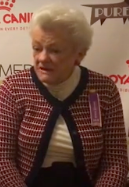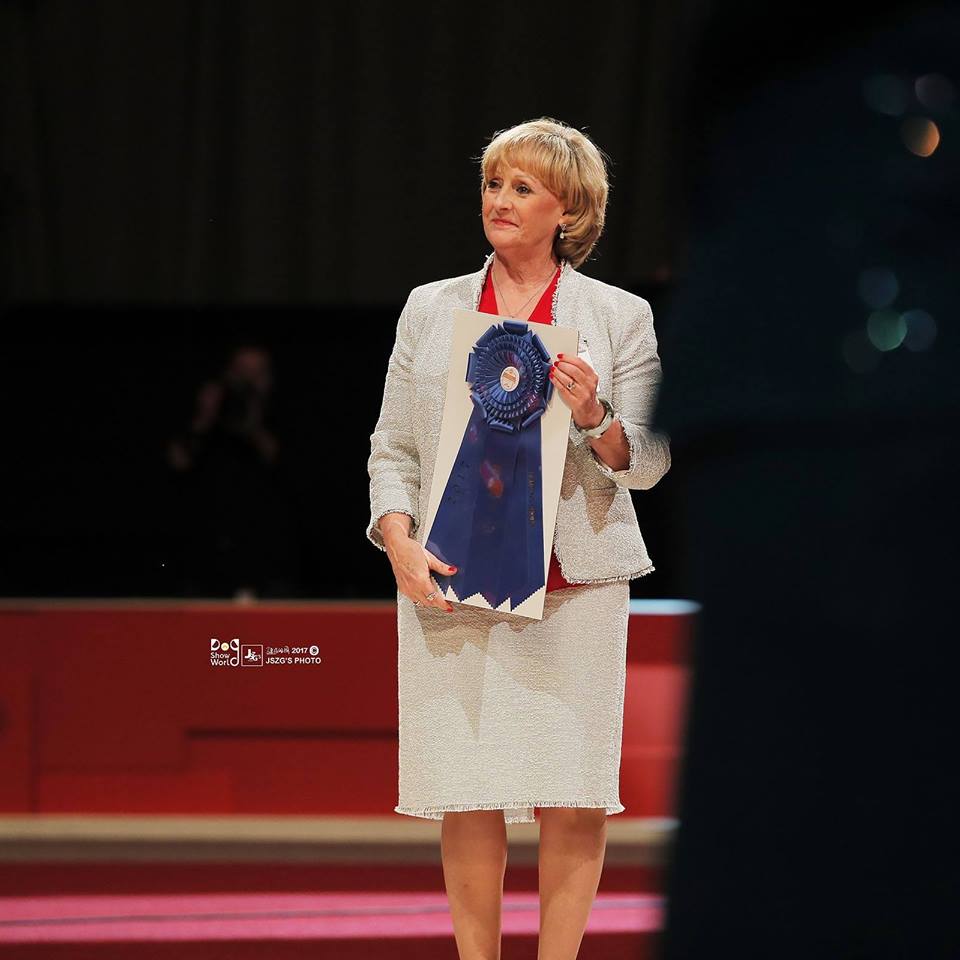222 — Lydia Hutchinson on Cairn Terriers and 54 Years Judging
Loving life and living for Cairn Terriers
I visited with Lydia Hutchinson, renowned AKC judge and breeder, owner, handler of Wolfpit Cairn Terriers, at Westminster Kennel Club earlier this year. After a day of stewarding, this enthusiastic septuagenarian was bubbling with enthusiasm about pedigrees, breeding and the sport of conformation dog shows.
Watch the video.
A lifetime in dogs
“I wasn’t quite born in to (dogs),” Hutchinson said, “But my parents got their first Cairn Terrier two months before I was born.”
Following a familiar path, Hutchinson and her family eventually wound up at a dog show. The year was 1949 when she attended her first dog show “when I was 9 years old.”
In the intervening 70 years, Wolfpit Cairns have produced 270 champions, Hutchinson said, almost exclusively homebred and largely owner handled.
Breeding, handling, judging
Hutchinson is still actively breeding and showing her Cairns. She said showing and judging dogs at the same time maintains her sensitivity to exhibitors, keeps her up to date and “keeps you young.”
Cairn Terriers are a breed noted for their adaptability, alertness and independence, Hutchinson said. She calls Cairn grooming for the show ring, “achieved naturalness.”
As she developed the family’s Wolfpit line of Cairns, Hutchinson said she utilized principles of line breeding learned from early Poodle mentor. She imported bitches from Europe looking to improve coats and fronts, but building on her program’s established sire line.
“I still hand-write pedigrees,” Hutchinson said. “I know it’s old-fashioned, but it helps solidify the pedigree in my mind.”
Hutchinson started judging in 1964 “when I was 7 months pregnant with our second child. She judges terrier, toy, herding, poodles, schnauzers. She noted that she wants to “have a relationship with a particular breed to want to judge them.”
“There is not a dog show I go to that I don’t learn something,” Hutchinson said. “Using your eyes, asking questions of knowledgeable people, you’ll learn.”
There’s something about the sport of dogs that’s very energizing, Hutchinson observed.
“I love life, I love my dogs. I’ve been married to my husband for 57 years. I’m not tired at all! I’m looking forward to tomorrow.”
161 – Peggy Beisel-McIlwaine on Judging Dogs as Breeding Stock
PEGGY BEISEL-MCILWAINE – JUDGING DOGS AS BREEDING STOCK
Peggy Beisel-McIlwaine was recently nominated for the third time as judge of the year by the ShowDog of the Year Committee. A judge of four groups, Beisel-McIlwaine is well respected within the fancy for her over-arching mission to judge dogs as breeding stock. She’s judged the Garden, Montgomery and Great Western, as well as internationally. Her gentle hands on the dogs, discerning eye for a “good one” and her pleasant demeanor with exhibitors have made her a favorite.
Her first love, an Old English Sheepdog acquired after high school, eventually led Beisel-McIlwaine to work dog shows on weekends for Connie Gerstner (Miller). “I went to UWGreenBay. Eventually, I was going to classes less and less and dog shows more and more,” Beisel-McIlwaine said.
In the spring of 1977, at a local Wisconsin show, she encountered legendary dog man and Terrier handler George Ward. He was looking for full time help and Beisel-McIlwaine wanted to learn. “I never intending to be a professional handler, but I wanted to learn more about dogs and breedings. I fully intended to breed Old English Sheepdogs,” Beisel-McIlwaine said. She was impressed by the cleanliness and quality of his kennel and fell in love with Wire Fox Terriers. And, she says, she’s never looked back.
“It was great,” Beisel-McIlwaine said. “(Ward) had a special bond with the dogs. He said I was a great student because I didn’t have any bad habits to unlearn.
“I stayed until May 1980. George was not an easy person to work for. But I’m glad I learned terriers from him because I didn’t learn any short cuts. I don’t like to see terriers run in the ring. They’re not bred to be raced around the ring. To see proper movement, you need to see them at the right speed. I’m old school.
WHAT GEORGE WARD TAUGHT PEGGY:
“George taught me three things when I first started working for him:
* never keep your hands in your pocket, it makes you look like you’re not serious
* never chew gum in the ring
* talk to the dogs in the ring, don’t let them think they’re in there alone…. I like to see kids in Juniors talking to dogs in the ring
DOGS COME FIRST
“The kennels were clean. The dogs came first. We’d go to a show and if it was too hot, we went home. His clients understood that. Grooming and care of the dogs were number one.
He and Dick Cooper were good friends, so we were always set up together. I’d just sit there and soak up all the stories.
“I remember going to shows, playing cards and it was so much fun. I think we’re a little too stiff some times these days. You’ve gotta have a little fun. Maybe because of the PC attitude, we’ve taken some of the fun out of it.”
CAIRN TERRIERS AND SANDY MCILWAINE – FOXAIR KENNELS
When Beisel-McIlwaine left Ward’s employ, she married Cairn Terrier fancier Sandy McIlwaine. Together their Foxairn dogs have “finished a multitude of Cairns” and 15 homebred Wires. Foxairn has twice produced the number-one Cairn in the country, one of whom was a two-time national-specialty winner. Peggy was handling professionally and Sandy managed the kennel and the kids. “He was the original Mr. Mom,” she noted.
As her children grew up, Beisel-McIlwaine wanted to spend more time with them and less time on the road. So, she quit handling and started judging. “Family comes first. We had a couple slim years. But I was fortunate and I got the whole terrier group.”
For our listeners who heard Dana Cline’s interview, Beisel-McIlwaine’s comments on what makes a great dog will begin to sound familiar.
“You have to have the type,” Beisel-McIlwaine said. “Annie Clark said from the best type you pick the best movement. What makes a dog great is the showmanship. Now, I don’t want a bloodhound showing like a fox terrier. I want a bloodhound to be a bloodhound. Showmanship and character has to go along with the breed. But, for me, to be great the dogs also have to be able to produce. I think what we’re doing is judging breeding stock. We’ve had lots of top winning dogs, but when they also produce other top quality specimens, that’s when I call them great.”
FIVE ELEMENTS OF TYPE
Beisel-McIlwaine strongly recommends Ric Beauchamp’s book “Solving the Mysteries of Breed Type” and understanding the five elements of type.
“Type is spelled out in the standard,” Beisel-McIlwaine. “There is only one correct type, but there are elements of style. If you took every Best in Show winning Wire Fox Terrier from the last 20 years and put them in the ring, you’d see big differences… Spot On, Dominator, Lonesome Dove, Special Edition… They are all so different.”
SPARRING IN JUDGING TERRIERS
One of the lost arts of judging terriers, Beisel-McIlwaine contends, is sparring the dogs in the ring.
“(Sparring) is so important to do,” Beisel-McIlwaine said. “Especially when you have a nice group of terriers. It is NOT fighting, and not all breeds do it. It is showing the confidence. One of my favorite lines (from Wire Fox Terrier standard) is ‘on the tip toe of expectation.’ We want that fire. It’s trash talk, (the dog is saying) ‘I own this ring, I’m allowing you in this ring, but not for long’…
“Irish and Kerries are real tough…. they can set off real quick…. Cairns and Westies were bred to work together…but they won’t back down… Scotties want to do it all themselves.
“In (other countries) they won’t do it. It’s so frustrating. Instead of teaching people why we spar or dock or crop, we back down. We’re just saying, ’OK, it’s bad, we won’t do it anymore… you win.’ The Animal Rights people are taking control. There is nothing more beautiful than seeing two or three terriers standing their ground looking at each other, probably saying a few curse words and then walking away…
Beisel-McIlwaine worked with other judges at the Terrier Club of Michigan to create a “sparring seminar” that is available for purchase here. A discount is offered for judges who’d like to learn more about how to properly and safely spar dogs in their rings.
BEISEL-MCILWAINE’S ADVICE TO OWNER HANDLERS
Finally, Beisel-McIlwaine gives encouragement and a caution to owner handlers.
“Nowadays (with all the shows) I don’t know when handlers have time to get dogs properly trimmed,” Beisel-McIlwain said. “Owner Handler dogs are often in better condition. I think Owner Handlers can do it.
“But I get offended when people say they can’t. That judges only put up Professional Handlers. I’m sure there are those that don’t have confidence and they put up Professional Handlers. But I don’t think it’s fair to say Owner Handlers can’t compete. I know they get discouraged. The Owner Handled series is popular, but it’s sad they even had to do it.
“(Unfortunately) people aren’t coming up and asking for help. (People) are in it for five years and get out because they know everything. Most people are more than willing to help people out. But you have to be brave enough to ask. We do want the sport to succeed. I’m a huge proponent of bench shows. I think it’s sad to see them dying out. We’d sit and listen to people. Go over dogs. They’d show you how to examine the dogs, what to look for. Today, half of the people don’t stay past 6-9 puppy dog if they don’t win.”


